Overview
- Features: Ruins of several temples around Hampi
- Opening Times: Dawn to dusk, daily
- Best Time to Visit: Late October to early March
- Duration: Half a day
- Travelled By: Foot
- Cost: Free (except for Virupaksha Temple, Vittala Temple and entrance to Royal Centre)
- Address: Hampi, Karnataka, India
- Type: Historic site, Temple
Author Reviews[display_rating_item_results rating_form_id=”2″ rating_entry_ids=”1″ show_category_filter=”false” show_options=”true” result_type=”star_rating” preserve_max_rating=”true” show_title=”false” show_count=”false” ]
Total Rating: [display_rating_result rating_form_id=”2″ show_count=”false” show_rich_snippets=true] [accordions load=”1″] [accordion title=”User Reviews” last] [display_rating_item_results rating_form_id=”5″ show_options=”true” result_type=”star_rating” preserve_max_rating=”true” show_title=”false” show_count=”true” show_rich_snippets=true] [/accordion] [accordion title=”Add Review”][display_rating_form show_email_input=”true” show_comment_textarea=”true” show_name_input=”true” rating_form_id=”5″] [/accordion] [/accordions]
Summary
Climb any boulder-toppled mountain around the ruins of the Vijayanagar Empire and you will see the dizzying scale of the Hindu conquerors’ glory. This site of desolate Hampi temples, compounds, stables and pleasure baths, surrounded by a stunning boulder-strewn landscape will surely impress.
Hampi Temple
The fabled city of the Vijayanagar kings, covering an area of around 20 sq km (8 sq miles), sprawls across a spectacular barren and boulder-strewn landscape. As one meanders their way through Hampi’s ruins, it becomes obvious that the Vijayanagara kings built several Hampi temple complexes in this area.
[singlepic id=1733 w=720 h=560 float=center]
The Sacred Centre, on the southern bank of the Tungabhadra River, is dominated by the impressive Virupaksha Temple. It is dedicated to a form of Shiva (Virupaksha), known here as Pamapapati (the “Lord of Pampa”), and commemorates his wedding to Pampa, the goddess of the Tungabhadra.
In front of Virupaksha Temple is the colonnaded Bazaar Street that dates mainly from the 16th to the mid-17th centuries, when it teemed with pilgrims and travellers in search of exotic wares.
A path beside the river leads past the Kodandarama Temple, with its figures of Rama, Sita and Lakshman carved on to a boulder inside the sanctuary. The bathing ghats here are considered to be the holiest at the site.
[singlepic id=1695 w=720 h=560 float=center]
Beyond lies the Temple of Achyuta Raya, one of the major Hindu complexes at Hampi, dating from 1534 and dedicated to Tiruvengalanatha, the form of Vishnu that is venerated at Tirupati. Its perfect plan of two concrete enclosures, each entered by a towering gopura to the north, is clearly visible from the summit of Matanga Hill.
[singlepic id=1703 w=720 h=560 float=center]
[singlepic id=1716 w=720 h=560 float=center]
The riverside path continues to the Vittala Temple, the undisputed highlight of the Hampi ruins and the grandest of all the religious monuments in the Sacred Centre. Now a World Heritage Monument, this 15th century temple represents the high point of Vijayanagar art and architecture. The centrepiece of this site is a stone chariot with spinning wheels.
From here a road proceeds to the village of Kamalapuram, where the Archaeological Museum is located. En route is a gateway with a damaged façade of windows and battlements.
[singlepic id=1707 w=720 h=560 float=center]
The road that runs south from Hampi village, through the Sacred Centre leads up to the Group of Temples on Hemakuta Hill, a hillock scattered with numerous pre- and early Vijayanagar shrines and mandapas, many with small pyramidal towers. More than thirty shrines stand on this hill. These vary from elaborate structures with multiple sanctums to rudimentries, single celled construction. Most of these temples have stepped pyramidal type of superstructure.
[singlepic id=1696 w=720 h=560 float=center]
[singlepic id=1699 w=720 h=560 float=center]
The characteristic features of these temples are three shrines facing east, west and the north with a common ardhamandapa and a front porch. A group of small stone shrines face different directions. The rocks here contain many rock-cut lingas.
The group of temples on the Hemakuta Hills form one of the earliest groups of structures at Hampi and appear to date from about 9th to early 14th century A.D.
[singlepic id=1698 w=720 h=560 float=center]
[singlepic id=1697 w=720 h=560 float=center]
A large image of the elephant god, Ganesha, carved on a boulder, marks the top of the ridge. Situated on the south eastern slopes of the Hemakuta hillock, this monolithic Ganesha is four armed and referred to as the Sasivekalu Ganesha due to its closeness in appearance of the shape of its belly to a mustard seed. The statue, seated in a half lotus posture (Ardha Padmasana) bears a tusk, goad, noose and bowl of sweets in its four arms. This open pillared mandapa (pavilion) was built in 1506 A.D. by a trader in memory of King Narasimha II (r. 1491-1505 A.D.) of the Saluva dynasty.
[singlepic id=1701 w=720 h=560 float=center]
Further south is the Krishna Temple, erected in the early 16th century during the reign of Krishnadeva Raya. It was built to commemorate his victory over Orissa. This large and ornate east-facing temple was consecrated with an icon of Balakrishna brought from Orissa by Krishnadeva Raya. It is no longer a place of worship.
[singlepic id=1704 w=720 h=560 float=center]
It is entered through a massive, though partly ruined gopura. The temple complex built in Panchayatana style with two enclosures, has the main shrine with the sanctum, a vestibule, pillared pavilions and halls, a Devi shrine and many sub-shrines. The temple walls are carved with depictions of the Bhagavata, the puranic story of Lord Krishna and the life of the times. The pillars of the mahamandapa have sculptured depictions of the ten incarnations of Lord Vishnu including the rare one of Kalka, depicted as a seated figure with a horse’s head. The main entrance leads out to a street bazaar and a sacred water tank.
[singlepic id=1706 w=720 h=560 float=center]
[singlepic id=1700 w=720 h=560 float=center]
The colonnaded street to the east now runs through fields of sugarcane, while the square tank nearby still stores water. As it continues south, the road travels past the tremendous Narasimha Stone Monolith, a representation of Vishnu’s manlion incarnation, housed in the Lakshmi Narasimha Temple. Carved out of a single boulder in 1528, this awe-inspiring fourth incarnation of Lord Vishnu shows him in his half man-half lion incarnation. Standing at a height of 6.7 metres, it is one of the finest examples of Vijayanagara sculpture. Narasimha is seated on the giant coils of Adishesha, the sacred guardian snake of Vishnu, its seven hoods acting as a canopy arched by a kirtimukha torana in front.
The roof of the chamber enshrining the statue is missing which has led to much weathering and damage to this monolithic sculpture. The four arms of the statue with its various attributes have been broken and the seated figure of his consort Lakshmi on his left lap is missing. The face too has been damaged which misled people into believing that it was the Ugranarasimha or Angered Narasimha. The presence of the right hand of the Gods embracing the Lord at the back is proof of it being that of Lakshmi Narasimha.
[singlepic id=1708 w=720 h=560 float=center]
Nearby is the Badavilinga Temple with a 3 metre-high large monolith Shiva linga carved out of one rock. The pedestal remains in a bed of water in a damaged shrine. Referred to as Badavilinga, it is believed to have been commissioned by a poor woman. The Shiva linga has a fairly large circular pedestal (Yone Pitha), drawing into an outlet (Pranala). The central median line (Somasutra) has the three-eye mark, drawn in line carving. The sanctum chamber that houses the Shiva linga is a large stone, brick and mortar structure.
[singlepic id=1665 w=720 h=560 float=center]
Fortified walls enclose the Royal Centre. The temples built in this area were directly associated with royalty. At the core of the Royal Centre is the superb Hazara Rama Temple, built by Deva Raya I, a Vijayanagar king of the 15th century. Its outer walls are covered with friezes that depict ceremonies of the Mahanavami festival. Reliefs of episodes from the Ramayana can be seen here.
Around the temple are excavated remains of palaces, baths and a hundred-columned audience hall, while to its north are the Elephant Stables and the Lotus Mahal.
[singlepic id=1660 w=720 h=560 float=center]
[singlepic id=1653 w=720 h=560 float=center]
Further south are a number of other temples including the Underground Shiva Temple. The temple has a Garba griha with an Antarala and Aradhamantapa and a Mahamantapa (main hall). The mahamantapa has pillared corridors that fuse with the pillared Mukhamantapa, making a larger pillared frontal Mantapa which also encloses a Dwajasthamba. The pillars of this temple are plain. An inscription referring to this temple states that Krishnadevaraya donated Nagalapura and other villages for worship and offerings to the Gods for the merit of his parents Narsa Nayaka and Nagaji Devi.
At times the base of the temple is flooded and may be inaccessible. When it is accessible, masses of small bats may be found in the temple.
[singlepic id=1654 w=720 h=560 float=center]
Climb any boulder-toppled mountain around the ruins of the Vijayanagar Empire and you will see the dizzying scale of the Hindu conquerors’ glory. This site of desolate Hampi temples, compounds, stables and pleasure baths, surrounded by a stunning boulder-strewn landscape will surely impress.


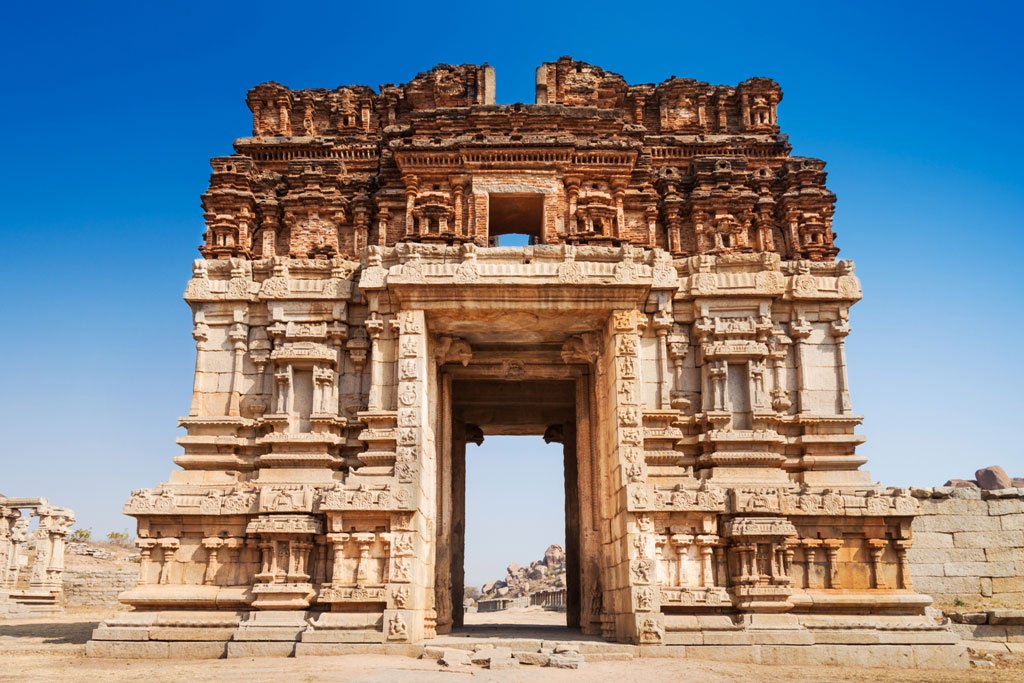
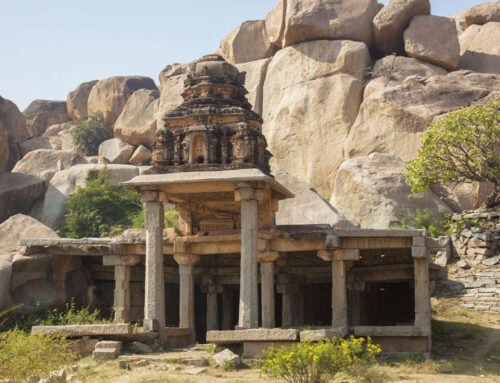
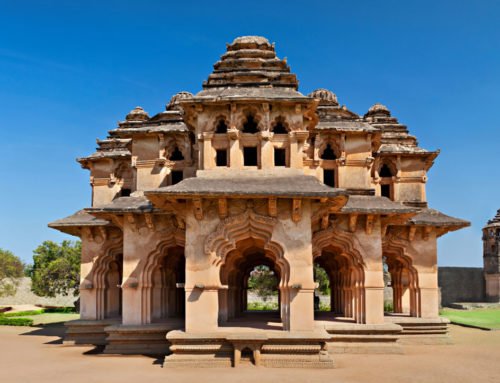
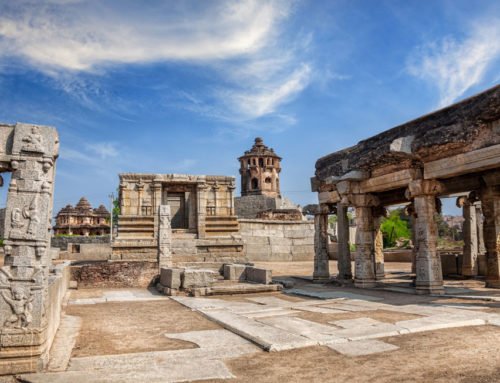

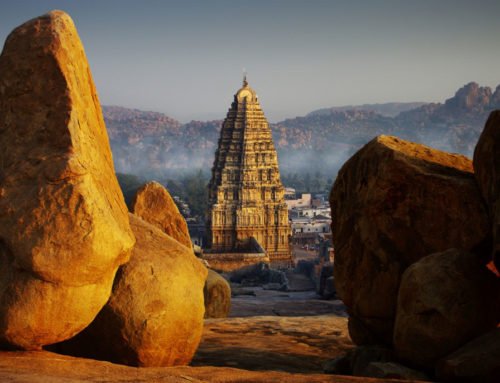
Are there any accommodation places near the temple? Restaurants, markets, anything?
Hi Mia, there are a few smaller hotels and restaurants close to the temples. These are generally small operations without websites. Hopefully this will change and that the hotel standards will also increase with greater visibility.